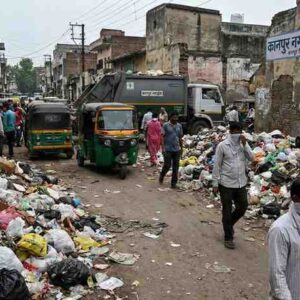India’s Balancing Act Between Economic Growth, Environmental Sustainability, and Democratic Governance
Key Highlights:
- Economic Growth: India’s GDP grew at 7.2% in 2024, driven by industrial expansion and urbanization (Ministry of Finance, 2024).
- Environmental Impact: India ranks third globally in greenhouse gas emissions, contributing 2.7 billion metric tons of CO₂ annually (Global Carbon Project, 2024).
- Public Participation: Environmental movements like the Chipko Andolan and Save Aarey Forest highlight democratic activism in response to environmental challenges.
- Government Expenditure: India allocated ₹20,000 crore in 2024-25 for renewable energy projects, signaling a commitment to sustainability (Union Budget, 2024).
Introduction
In India, democracy, capitalism, and environmental sustainability form a complex and often contradictory relationship. While democracy empowers citizens to demand accountability, capitalism fuels economic growth that frequently comes at the expense of the environment. This article explores the challenges and opportunities that arise as India seeks to balance these forces, delving into policy decisions, public activism, and the impact of industrialization.
The Role of Capitalism in Environmental Challenges
1. Industrial Growth and Resource Exploitation
India’s economic policies emphasize industrial expansion to sustain GDP growth, but this often leads to resource depletion:
- Urbanization Impact: By 2024, over 35% of India’s population resided in urban areas, requiring large-scale land use and infrastructure development (Census of India).
- Coal Dependency: Coal-fired power plants accounted for 72% of India’s electricity generation in 2024, contributing significantly to air pollution and CO₂ emissions (Ministry of Power, 2024).
2. Private Sector Influence
Capitalist ventures prioritize profits, often sidelining environmental concerns:
- Deforestation for Industry: Over 14,000 hectares of forest land were diverted for industrial projects in 2024, despite environmental protests (Ministry of Environment, Forest and Climate Change, 2024).
- Corporate Accountability: Weak enforcement of environmental regulations allows industries to bypass compliance, exacerbating pollution.
Democratic Responses to Environmental Concerns
1. Public Activism and Movements
India’s democratic framework enables citizen participation in environmental protection:
- Chipko Andolan: A historic movement where villagers hugged trees to prevent deforestation.
- Save Aarey Campaign: In 2024, activists successfully protested against cutting 2,700 trees for a metro project in Mumbai, reflecting the power of collective action.
2. Judicial Interventions
The Indian judiciary has played a pivotal role in upholding environmental norms:
- Ganga Pollution Case: The National Green Tribunal (NGT) fined industries ₹500 crore in 2024 for discharging untreated effluents into the Ganga River.
- Air Pollution Regulations: Supreme Court directives led to restrictions on firecrackers and construction activities in Delhi-NCR to combat rising pollution levels.
Policy Framework: Balancing Growth and Sustainability
1. Renewable Energy Push
India is investing heavily in renewable energy to reduce its carbon footprint:
- Solar Energy Capacity: India’s solar energy capacity reached 75 GW in 2024, with a target of 280 GW by 2030 (Ministry of Renewable Energy).
- Green Hydrogen Mission: Launched with an outlay of ₹19,744 crore, the mission aims to make India a global hub for green hydrogen production.
2. Carbon Markets and ESG Initiatives
To align capitalism with environmental goals, India introduced:
- Carbon Credit Trading: A market-based mechanism to reduce emissions, launched in 2024 under the Paris Agreement commitments.
- Corporate ESG Compliance: Companies are required to disclose environmental, social, and governance (ESG) metrics, ensuring transparency and sustainability.
Challenges in Aligning the Trifecta
1. Policy-Implementation Gaps
Despite progressive policies, on-ground execution remains weak:
- Forest Conservation: Only 65% of afforestation targets under the National Afforestation Programme were met in 2024.
- Waste Management: India generates 65 million metric tons of waste annually, with only 70% scientifically processed (Central Pollution Control Board, 2024).
2. Political and Corporate Interests
Economic pressures often overshadow environmental priorities:
- Election Promises: Political parties prioritize job creation over sustainability, delaying critical climate action.
- Industrial Lobbying: Private sector influence often leads to dilution of environmental impact assessments (EIA).
Voices from the Ground
- Environmentalists: “While India’s renewable energy push is commendable, unchecked industrial growth continues to harm fragile ecosystems,” says Dr. Meera Raghavan, an environmental scientist.
- Corporate Leaders: “Sustainability is a long-term goal, but balancing it with profitability is challenging, especially for MSMEs,” says Ramesh Gupta, CEO of a manufacturing firm.
- Citizens: “Democracy allows us to protest against harmful projects, but we need stricter policies to hold corporations accountable,” says Aarti Sharma, an activist from Delhi.
Recommendations
To ensure a balanced approach to democracy, capitalism, and the environment, India must:
- Strengthen Regulations: Enforce stringent penalties for non-compliance with environmental laws.
- Promote Sustainable Development: Integrate green technologies into industrial processes and urban planning.
- Enhance Public Participation: Empower communities through awareness campaigns and legal tools to hold governments and corporations accountable.
- Global Partnerships: Collaborate with international organizations to access technology and funding for sustainable initiatives.
Conclusion
India’s journey toward balancing democracy, capitalism, and environmental sustainability is fraught with challenges but also marked by resilience and innovation. Public activism, judicial oversight, and policy reforms offer hope for a future where economic growth aligns with environmental preservation. The question remains: Can India lead the way in transforming this troubling trifecta into a harmonious synergy?













